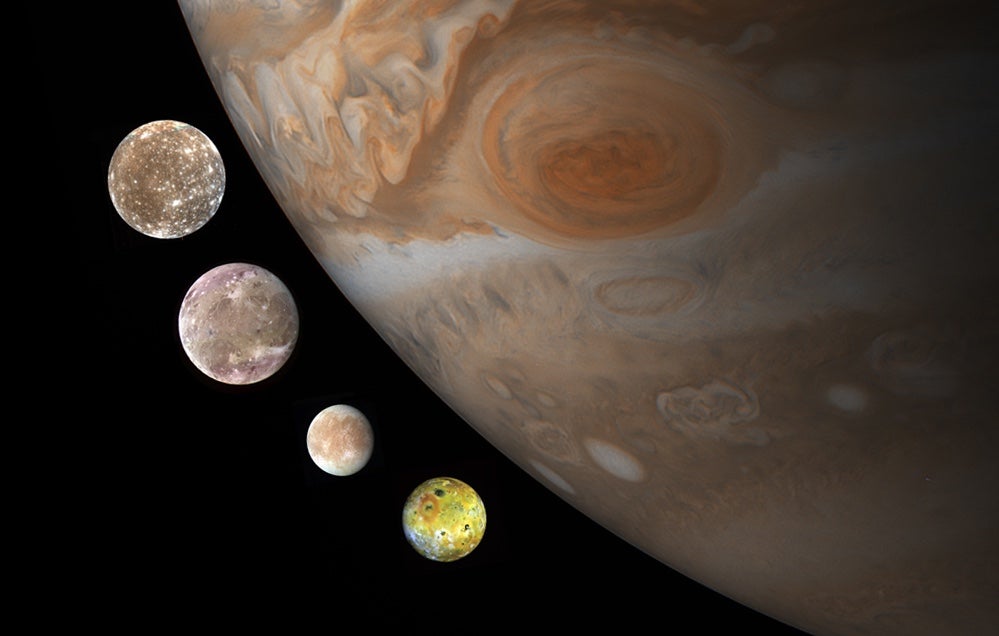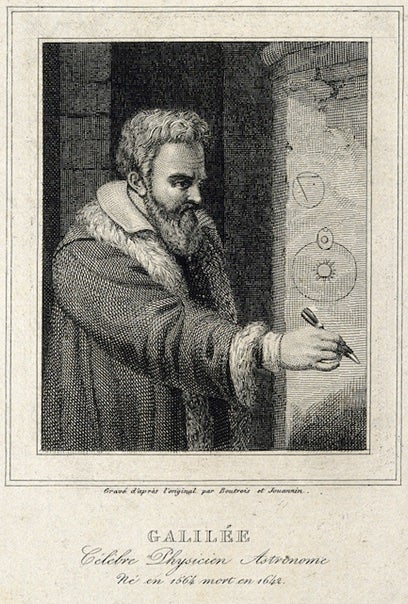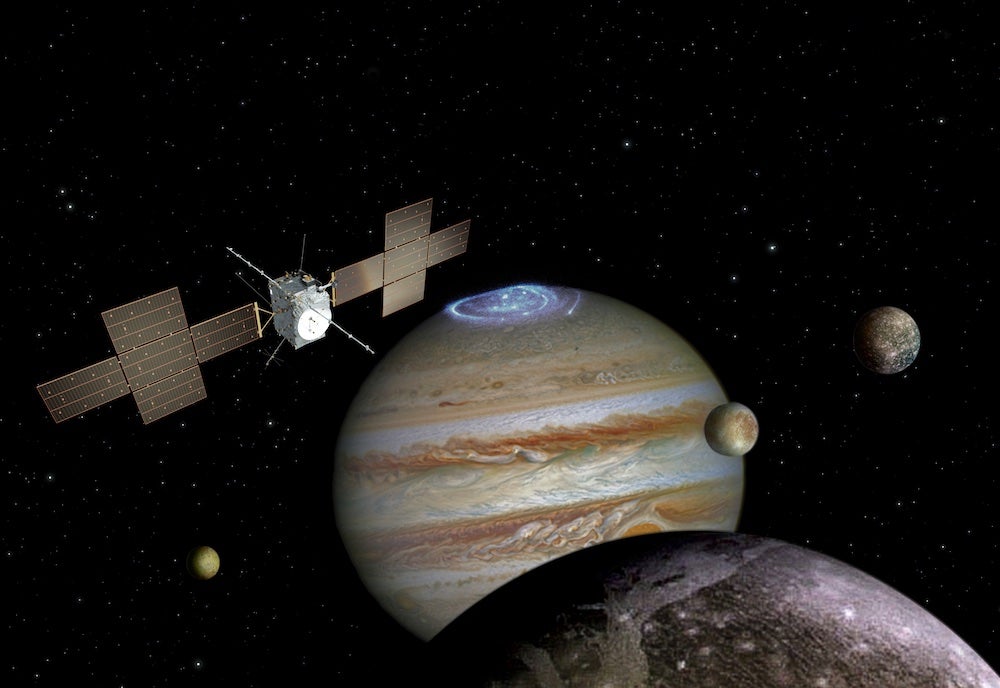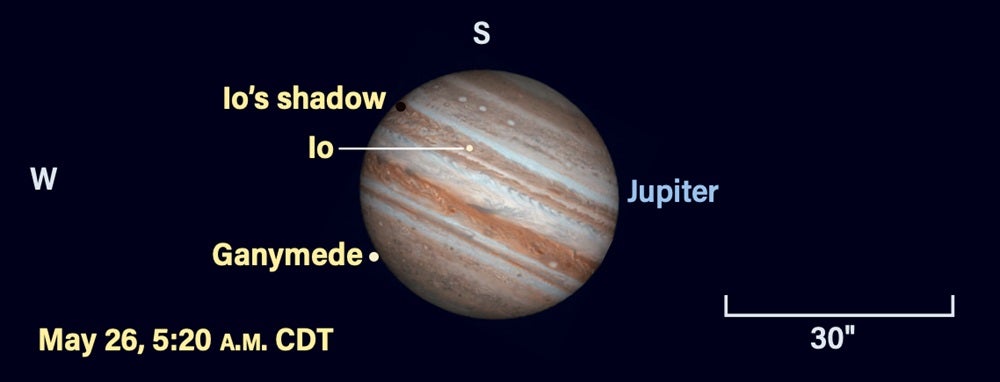
As the citizens of Padua, Italy, watched the Sun set on the evening of Jan. 7, 1610, none of them could have known that somewhere in their beautiful city, standing on a balcony high above them, a man was preparing to not only make history, but transform our very understanding of our place in the universe.
That man was scientist, inventor, and visionary Galileo Galilei.
As darkness fell over Padua, Galileo gazed out over the city rooftops to the east to where the constellation Orion, and above it, a nearly Full Moon, were on the rise. To the brilliant Moon’s upper-right, he saw a blue-white star, brighter by far than any of the stars around it.
As a scholar of science who was familiar with the sky and its workings, Galileo knew that this point of light was no star; it was the planet Jupiter. With great eagerness, he swung his new and improved telescope toward it, curious to learn what he would see.
Galileo sets his telescopic sights on Jupiter

Galileo’s first crude telescope only magnified objects a few times, barely enough to change their appearance. But the modified telescope he swung toward Jupiter that January evening had a very respectable magnification of 20x. As Galileo peered into the telescope’s eyepiece and jiggled the instrument around, searching for the planet, he must have been very impatient for it to finally swing into view.
When it eventually did, Galileo was amazed to see Jupiter wasn’t alone. There were several small, pinprick stars flanking it — two on one side, one on the other — all bathed in the bright planet’s metallic glare. Like any good observer, Galileo recorded what he saw, pondered on it for a while, then likely swung his telescope to other targets.
But on subsequent clear nights, Galileo returned to Jupiter again and again, each time seeing strange companions close to it. Intriguingly, their numbers changed from night to night, as did their arrangement. On some evenings, as many as four companion stars were visible, arranged in pairs on either side of Jupiter, or three on one side and one on the other, or even all four on the same side.
There was only one explanation, Galileo surmised: The “companion stars” were objects going around Jupiter. But that meant that Jupiter didn’t go around the Earth, as everyone had thought, and Earth wasn’t really the center of the universe.
The Galilean moons come into focus
Four centuries later, we know that those points of light seen fluttering in the eyepiece of Galileo’s telescope were, in fact, the moons Io, Europa, Ganymede, and Callisto — the four largest of Jupiter’s extended family of moons.
For many years, Jupiter trailed behind Saturn for the record number of moons. But in January 2023, researchers announced the discovery of a dozen new moons around it. That Brough Jupiter’s total number of moons to 92, enough for the king of planets to leapfrog over Saturn at last. But of all Jupiter’s many dozens of moons, the four discovered by Galileo still remain the most observed, as well as the most fascinating. Astronomers and observers alike collectively refer to those four moons as the “Galilean satellites,” or “Galilean moons.”
And today, we know so much about each Galilean moon that they are almost considered planets in their own right.

We know the innermost Galilean, pus-colored Io, is covered in volcanoes that vomit out golden, molten sulfur as the moon gets tugged and squashed by Jupiter’s immense gravitational pull.
We know the next moon out, enigmatic Europa, has a cracked and streaked crust of bright ice that might hide a deep subsurface ocean of water.
We know Ganymede, a huge moon with an icy surface the color of frozen coffee, is as big as the planet Mercury.
And we know Callisto, the outermost Galilean, is one of the most cratered bodies in the solar system, sporting an impact basin named Valhalla that is some 1,850 miles (3,000 kilometers) wide.
We know all this because we have images of the Galilean moons so detailed that Galileo himself would have probably thought they were the products of witchcraft. Thanks to the cameras and instruments carried by robotic space probes like the Voyagers, Galileo (named after the Italian astronomer), Cassini, and most recently, Juno, we have thoroughly studied and photographed the surfaces of each moon. We now have maps showing all their craters, ridges, mountains, and volcanoes in almost as much detail as maps of Earth’s own Moon.
And those already impressive views are about to get even better.
On April 14, 2023, the European Space Agency is set to launch the JUpiter ICy moons Explorer (JUICE) spacecraft. This mission will spend several years studying the icy Galilean moons Europa, Callisto, and Ganymede in an attempt to better understand their formation, structure, and evolution.

Observing the Galilean moons
As fascinating as our modern digital portraits of the Galilean moons are, seeing the icy sparks of the jovian satellites with your own eyes remains one of the greatest thrills in amateur astronomy. As is the case with Saturn’s rings, you’ll never forget the first time you see them.
But if you’re a newcomer to the hobby, or have never observed the Galilean moons before, how do you spot them?
The good news is that, unlike many of the amazing things to be found in the night sky, you don’t need a budget-busting telescope the size of a battleship cannon to see the Galilean satellites. Although they are very far away, the Galilean moons are among the largest moons in our solar system, roughly the size of our own Moon. That means that they can be easily seen with just a small telescope. In fact, even a modest pair of binoculars will reveal the Galilean moons as tiny specks very close to Jupiter itself.
Larger telescopes show them more clearly, of course. And if you step carefully up a ladder to gaze into the eyepiece of a monster Dobsonian, you might even see hints of color and tantalizing suggestions of features on the moons. On particularly clear and still nights, large telescopes will give wondrous views of the Galilean satellites moving in front of Jupiter’s caramel- and cream-colored cloud bands. The black holes of the moons’ shadows sometimes cast themselves on Jupiter’s disk, too.
The most fascinating aspect of observing the Galilean satellites is the way they constantly swing into and out of view, as seen from here on Earth. We never see the same number and arrangement of moons two nights in a row. And if you are blessed with a long clear night, it’s possible to see one or more of them slowly vanish or reappear from behind Jupiter itself.

But how can you know in advance when the Galilean moons are going to be seen at their best? And how can you tell which peppercorn point of light is which moon?
The answer is in your pocket…
Pioneering planetarium programs like “Starry Night” and “The Sky,” written for desktop computers, revolutionized amateur astronomy in the 1980s and 1990s. And apps written for today’s smartphones and tablets have likewise transformed the way we look at the night sky and quickly identify things in it.
Almost every astronomy app will let you zoom in on a virtual Jupiter and immediately see which of the tiny dots around it is which moon. You can also slide forward or backward through time to watch the satellites whip around Jupiter, changing their positions and arrangement. And you can even plan when to aim your telescope at Jupiter to see certain moons transiting or being eclipsed by Jove’s disk.
That’s clearly all fantastic (and we’re very spoiled today). But even with a hi-tech hobby such as astronomy, sometimes less is more. Sometimes it’s enough to simply stroll outside on a clear night, aim your binoculars at Jupiter, and marvel at the sight of its strange companion stars shining close by.
And when you do, you might just feel that same shiver of excitement Galileo must have felt more than four centuries ago.









